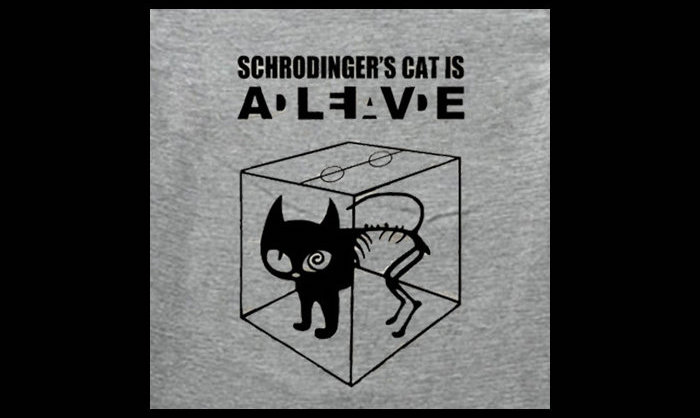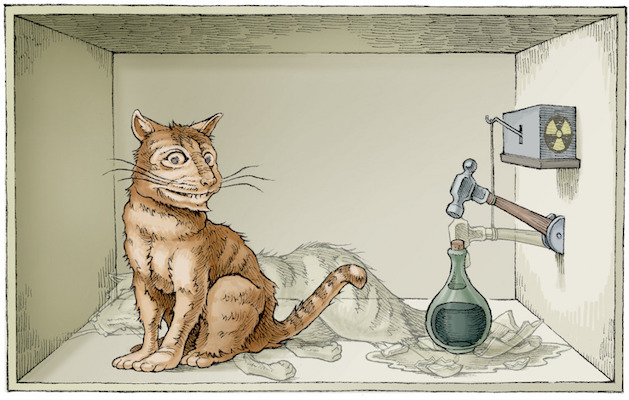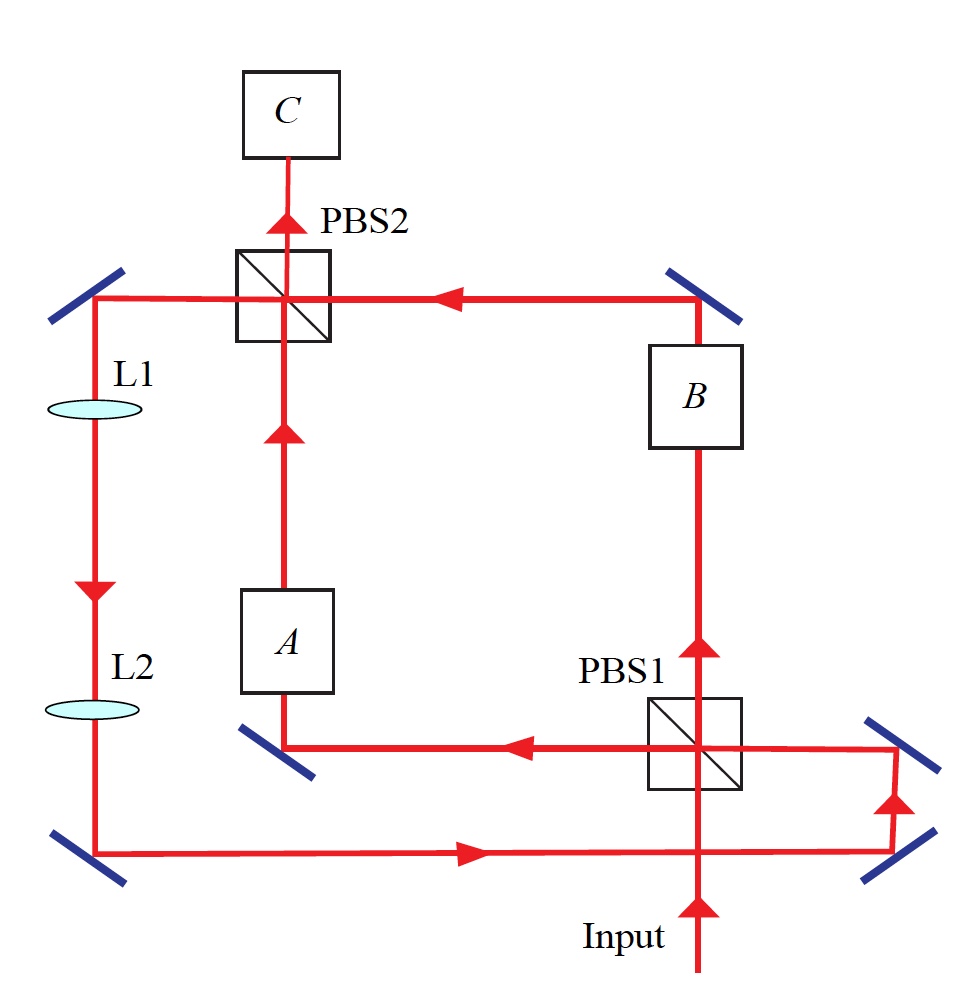Schrödinger's Quantum Switch

The world around us has been working on the laws of natural sciences since its inception. Any practical phenomenon, we can explain, based on the very laws. And now we already know that lightning is not the wrath of Zeus, the tsunami is not the scent of Neptune, the Earth is not flat, but huge turtles holding whole worlds on themselves do not exist. True, some particularly stubborn members of our race still believe in the last statements. But today we will talk about science, which likes to turn everything upside down, about quantum mechanics.
More specifically, it’s about research that experimentally demonstrates the fact that not always we have a single state of something. By applying knowledge from quantum mechanics, scientists were able to achieve an indefinite causal order in a quantum switch. What it is and how it works, we learn from their report. Go.
')
The basis of the study
Causation is a very familiar and understandable phenomenon. We know that a certain action leads to a certain result, as a rule. Of course, sometimes there can be different paths of development of events, but always one is chosen. So, for example, we can plant a seed in a pot, and the flower will grow or not grow. He cannot do both. It is worth remembering the wonderful theoretical experiment "Schrödinger's Cat".
In order not to stretch the story, the description of this experiment is hidden under the spoiler:
This theoretical experiment was described by Schrödinger himself in some detail and difficult, to some extent. The simplified version is:
There is a steel box. In the box is a cat and a mechanism. The mechanism is a Geiger counter with a very small amount of radioactive substance. This substance is so small that in 1 hour 1 atom can decay (and maybe not disintegrate). If this happens, the meter reading tube is discharged and a relay is triggered, releasing a hammer that hangs over the poison flask. The flask shatters and the poison kills the cat.
Now an explanation. We do not see what is happening in the box, we cannot influence the process, even with our observations. Until we open the box, we do not know whether the cat is alive or dead. Thus, exaggerating, we can say that for us the cat in the box is in two states at the same time: he is alive and dead.
Very interesting experiment, pushing the boundaries of quantum physics.
Even more unusual is Wigner's paradox. To all of the above experiment variables, some laboratory technician friends are added that are conducting this experiment. When he opens the box and finds out the exact state of the cat, his friend, being in another place, does not know this state. The first must inform the second that the cat is alive or dead. Thus, until everyone in the Universe knows the exact state of a poor animal, it will be considered both dead and alive at the same time.

This theoretical experiment was described by Schrödinger himself in some detail and difficult, to some extent. The simplified version is:
There is a steel box. In the box is a cat and a mechanism. The mechanism is a Geiger counter with a very small amount of radioactive substance. This substance is so small that in 1 hour 1 atom can decay (and maybe not disintegrate). If this happens, the meter reading tube is discharged and a relay is triggered, releasing a hammer that hangs over the poison flask. The flask shatters and the poison kills the cat.
Now an explanation. We do not see what is happening in the box, we cannot influence the process, even with our observations. Until we open the box, we do not know whether the cat is alive or dead. Thus, exaggerating, we can say that for us the cat in the box is in two states at the same time: he is alive and dead.
Very interesting experiment, pushing the boundaries of quantum physics.
Even more unusual is Wigner's paradox. To all of the above experiment variables, some laboratory technician friends are added that are conducting this experiment. When he opens the box and finds out the exact state of the cat, his friend, being in another place, does not know this state. The first must inform the second that the cat is alive or dead. Thus, until everyone in the Universe knows the exact state of a poor animal, it will be considered both dead and alive at the same time.
To study an uncertain causal order, a framework is used that determines whether an experimental situation (the process) refers to a fixed causal process or not. An example of a process of indefinite causal order is a quantum switch, in which black box * operations are performed on the target system, while the switch itself is coherently controlled by the control quantum system.
Black box * - in this case, the designation of operations that are not yet known.According to scientists, the main advantage of a quantum switch is the fact that it cannot be implemented using a conventional quantum scheme that uses the same number of black box operations.
And now the question that immediately arose in the minds of scientists - is it possible in the laboratory to implement this quantum switch? The fact is that at the moment the implementation of this technology does not take advantage of the quantum switch, since additional “black boxes” are used. In such an implementation, the order is controlled by the path chosen by the photons, while each “black box” (in this case, these are wave plates) acts depending on their polarization. That is, photons pass through wave plates at two different points in space, depending on the order. In addition, there is one more minus (or rather a limitation) - the coherence length of photons in such an implementation is much shorter than the distance between two wave plates. This means that operations can also differ in time, since some of them can be performed faster by controlling the wave plates.
Scientists are well aware that the implementation described above is fraught with many limitations. That is why they have focused on the quantum switch, which can overcome these limitations.

Image number 1: quantum switch.
Image No. 1 shows the operation of the quantum switch, where the controlling qubit is responsible for a specific order in which two quantum operations A and B are performed, aimed at the target qubit | t .
1a — when the controlling qubit is in the state | 0⟩ s , then as a result we have an operation of the form AB;
1b - when the controlling qubit is in the state | 1⟩ s , then the result is the operation BA;
1c - if the controlling qubit is in the state of quantum superposition 1 / √2 (| 0⟩ + | 1⟩) s , the order of operations also goes to quantum superposition. As a result, the overall state of the controlling and target system at the output is the following:

1d - the target qubit | ψ⟩t is encoded in the degree of freedom of polarization, whereas | 0⟩ and | 1⟩ are different paths of photons through wave plates. These paths implement operations A and B. Since the photons pass through the wave plates at two different points, we get 4 different operations: A1, A2 and B1, B2.
It is worth noting that in the implementation of a quantum switch, scientists used only 2 operations of the “black box” type, each of which was used only once. In the experimental system, the controlling qubit is encoded in polarization, and the target qubit is in the transverse spatial mode of the photon.
The researchers say that their interest in the quantum switch originates from the desire to realize the causal ordering of the quantum type, which no one else has done before.
Given this, in this study, causal relationships are defined as the ability to transmit signals between events . By events is meant the operations of changing, preparing, or transforming the physical system. As an example, scientists cite a photon passing through several lenses. This photon defines an event.
A causal structure is a network of possible causal connections between several events.
With the "local" terminology sorted out, now about the process. First, consider the relativistic cause-and-effect system. If event A is in the past in relation to event B, then we can send a signal from A to B. If the events are spatially separated (far apart in space), then there can be no signal exchange.
Here it is worth clarifying what “spatial separation” is by adding this concept to others associated with it.
Imagine two separate events: A and B. If you are fast enough, you can see both A and B. This is a temporary separation. If events are so far apart, then in order to see both of you have to move at the speed of light, this is the light division. If events A and B are further away from each other, when you cannot see both even moving at the speed of light, then this is a spatial separation. This is a slightly rude explanation.
As we already saw in the diagrams above, there are two operations A and B. In fact, there are three of them, there is another operation C. More about each of them.
A and B are operations on the target system, implemented along the two arms of the interferometer. But C is already the measurements of the controlling system, which are made after both events A and B have taken place. All three of these events must be recognized by a quantum switch.

The scheme of the experiment.
And now we will consider the scheme according to which the experiment was carried out. As we already know, the controlling qubit is determined by polarization, therefore there are two polarizing beam splitters - PBS1 and PBS2 . PBS1 directs the photon to event A or B, which implements the corresponding operations A and B in the spatial mode of the photon. Event C is represented by a polarization measurement describing the Stokes * photon parameters . To ensure the conformity of the modes, lenses were used ( L1 and L2 in the diagram).
Stokes parameters * - a set of values that describe the polarization vector of electromagnetic waves.A 100 kHz laser beam with a wavelength of 795 nm with a low-order transverse mode (HG 00 ) was used as the radiation source. Next, the laser beam was converted to HG 10 Hermitian-Gaussian mode by passing the beam through an element that adds the π-phase to half the beam. The result is a spatial mode that is a superposition of Hermitian-Gaussian modes. Next, Fourier filtering was used to remove most high-order spatial modes. Thus, the qubit space of the target system consists of first-order spatial modes (| 0⟩ = | HG 10 ; | 1⟩ = | HG 01 ). And the initial value of the target qubit | ψ⟩t is | 0⟩.
So, passing through the PBS1 polarization splitter, the beam is divided into two arms of the interferometer (scheme above). Here, two unitary operations A and B operate in a transverse spatial mode, although in ideal conditions they should not change the polarization of the beam. The upper and lower shoulders are connected to the output divider PBS2. The resulting mod is sent back to PBS1. Lenses provide conformity of the mode, that is, the mode re-entered into the interferometer, must coincide with the original mode.

Scheme for the implementation of operations A and B.
Prisms ( R ) rotate the incoming transverse mode. At one time, cylindrical lenses ( C ) lead to the π / 2 phase shift of the Hermitian-Gaussian components of the incoming photon. Spherical lenses ( L ) are needed to achieve conformity of the mod. Reflections in prisms can lead to polarization distortion. In order to compensate for these changes, the wave half-plate ( H ) and the wave quarter-plate ( Q ) are used. And φ is the phase plate. To implement the necessary operations, you need to adjust the angle of inclination θ 1 and θ 2 . For example, to convert HG 10 beam to HG 01, the beam must be R (θ 1 ) rotated 45 degrees, and the angle R (θ 2 ) is set to 0.
In the experiment, the scientists identified two main sources of possible errors: mode mismatch and incorrect installation of tilt angles.
The so-called “causal witness” was the main indicator of the system's operability, a parameter that demonstrates the ability of events A and B to correspond to unitary operations A and B. Also, to determine this parameter, Stokes parameters were taken into account.
Theoretical modeling of the system, prior to practical implementation, showed that ⟨S⟩ under ideal conditions will be approximately equal to 0.248. If we model the system, taking into account its real parameters, then -0.20 ⟨S⟩ ≲ -0.14.
A practical experiment showed a good result: ⟨S⟩ = -0.171 ± 0.009, which fits into the expected range. Thus, scientists have concluded that their system works in an uncertain causal order. The foundation of this achievement, researchers called polarization, or rather the manipulation of it, which allowed to implement the system in this way.
To get acquainted with the details of the experiment, I strongly recommend the report of scientists, available here .
Epilogue
This study touched only the surface of some aspects of such a complex and confusing science as quantum mechanics. However, continuing to work in this direction, as scientists say, they will be able to achieve even more impressive results, which can change not only computing technologies, data transmission, etc., but also our vision of the world as a set of laws of natural sciences that can lose their status. indestructible.
Thank you for staying with us. Do you like our articles? Want to see more interesting materials? Support us by placing an order or recommending to friends, 30% discount for Habr users on a unique analogue of the entry-level servers that we invented for you: The whole truth about VPS (KVM) E5-2650 v4 (6 Cores) 10GB DDR4 240GB SSD 1Gbps from $ 20 or how to share the server? (Options are available with RAID1 and RAID10, up to 24 cores and up to 40GB DDR4).
VPS (KVM) E5-2650 v4 (6 Cores) 10GB DDR4 240GB SSD 1Gbps until December for free if you pay for a period of six months, you can order here .
Dell R730xd 2 times cheaper? Only we have 2 x Intel Dodeca-Core Xeon E5-2650v4 128GB DDR4 6x480GB SSD 1Gbps 100 TV from $ 249 in the Netherlands and the USA! Read about How to build an infrastructure building. class c using servers Dell R730xd E5-2650 v4 worth 9000 euros for a penny?
Source: https://habr.com/ru/post/422581/
All Articles